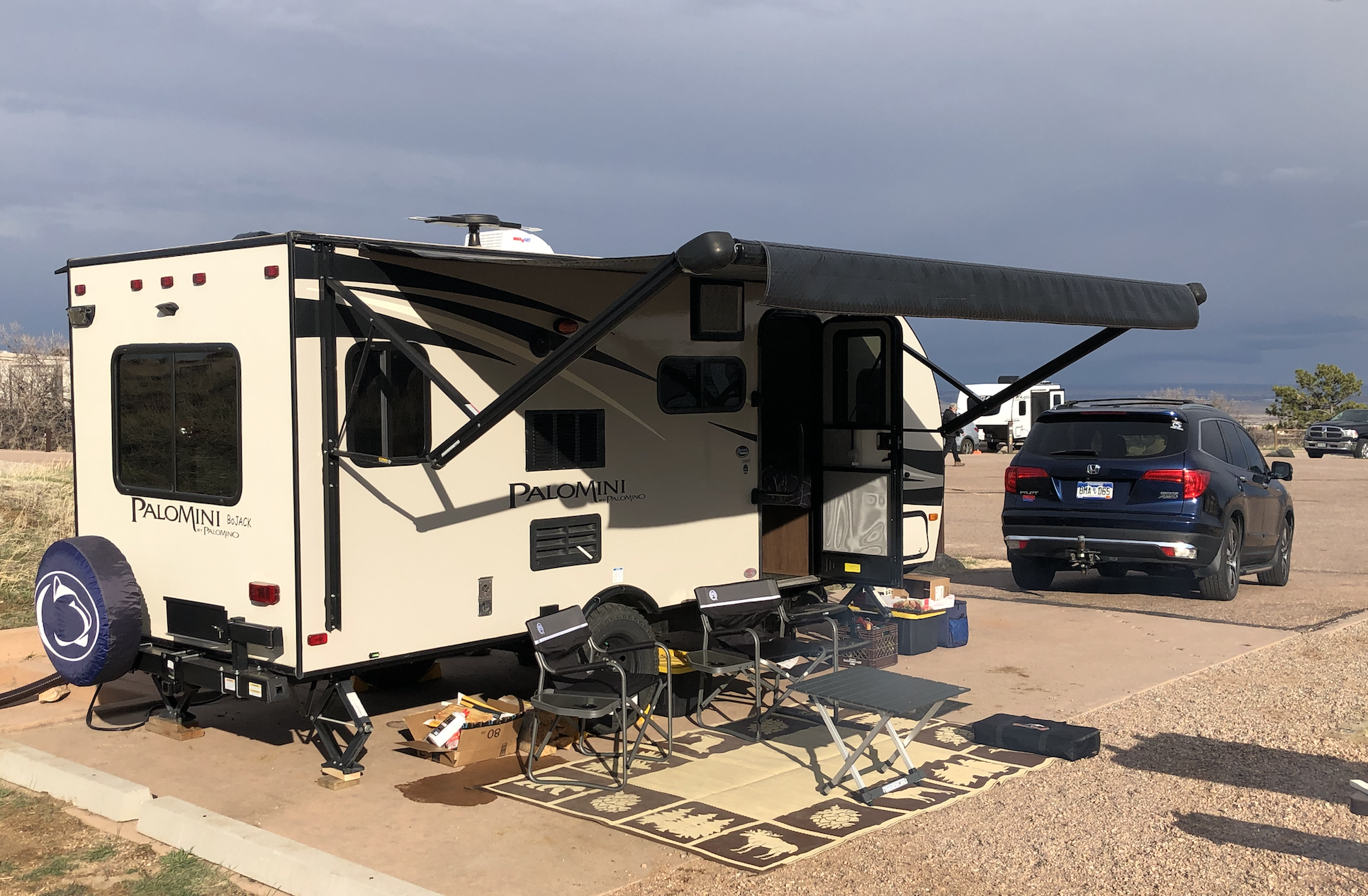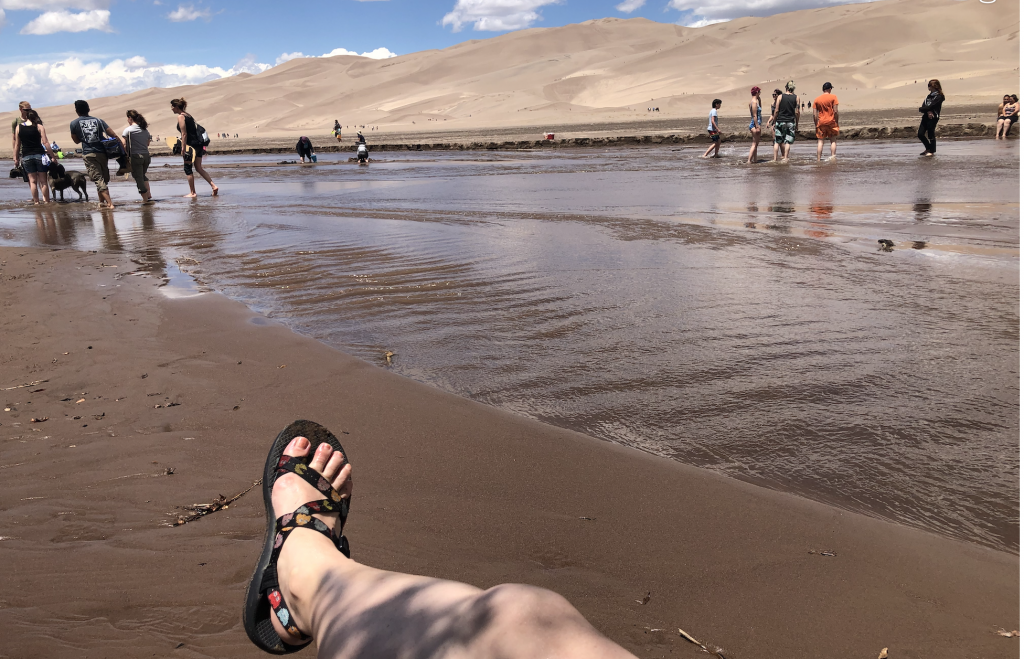
I figured I’d peel off two of the activities from our weekend in the San Luis Valley into separate blog posts. I realized I didn’t find a ton of consolidated information about spending a day at Great Sand Dunes National Park, so I figured I’d write about our personal experiences.
The Great Sand Dunes are exactly that: this unusual feature of sand dunes sitting in the middle of Colorado. A geologic abnormality, although it is well explained why this fine sand ended up in a pile nestled up against the Sangre de Cristo mountains. You definitely experience the southwest prevailing winds — which are responsible for the piling of the sand against the mountain range — while you’re there.
The creeks nearby and in the park also play a role in the geologic formations. Read about the park’s hydrology here.
When to Visit
We visited Great Sand Dunes National Park on Saturday, May 22, 2021. I think many will tell you that the month of May is the best time to go, because of Medano Creek “running”: the snowmelt flows down from the southwest slopes of the Sangre de Cristo Mountains nearby, and turns into a wide, shallow creek that flows across the base of the sand dunes on the southeast side of the park. The area just southeast of the main dunes area is transformed into a “beach”.
The trick, though, is that the start and stop dates for the “running” of the creek can be complicated to predict. It depends on the amount of snowfall the previous winter as well as the temperatures in May, which need to be warm enough to prompt the snowmelt. Also, the magnitude of the melting will contribute to how fast and deep the creek flows.
Just the same, the weekends in May are very crowded with visitors and Colorado natives who hang out at Medano Creek for a “day at the beach”. After the creek finishes flowing the snowmelt (usually in June sometime), the experience becomes much warmer and some will tell you that it’s downright unpleasant by July/August. The sand gets very hot, with no shade on the dunes.
Great Sand Dunes National Park is a small park. At least, compared to the Grand Canyon and Yellowstone. You could see much of it in a day…a LONG day, but I’d recommend at least 2 days to do everything comfortably.
What to Pack
Thanks to our neighbors here in Colorado Springs, who had camped at the park earlier in May, we received some good tips on what to take into the park. There is a visitor center about a mile from the parking for the creek area, but I’ll mention momentarily the difficulties with that.
- Water-friendly shoes. To get to the dunes themselves, while Medano Creek is running, you have to cross the creek. If the weather is warm enough, wearing sandals is a good idea.
- Sunscreen. Bring lots of it. You’re at ~8000′ at the base of the dunes, and above 8,500′ if you hike up to the top. Re-apply often.
- Water. Dave and I brought our stuff in Camelbak daypacks, we each had about 2 liters of water with us at the start of the day.
- Sunglasses. I recommend something inexpensive that you don’t mind getting a little wind-scoured.
- Hat with brim. And a means to tie it to your head.
- Windbreaker jacket. We are very glad we brought lightweight windbreakers with us. The wind is what creates the sand dunes, and you will not be disappointed. Temperatures were in the 60s during the warmest part of the day, but we still needed the jackets throughout.
- Older clothes. Don’t wear anything super nice — between the sand getting everywhere, getting wet, and scraping across the sand if you’re sledding, the clothing you wear to the dunes will look a bit rough after a day.
If you want to hang out on Medano Creek, you can also bring:
- Beach chairs/camp chairs
- Beach towels
- Snacks/food in a lightweight cooler. Make it a picnic! To our knowledge, there are no prepared food sales at the park, but there’s a little general store at the campground, and the Great Sand Dunes Oasis sells snacks and has a restaurant on site, but it’s outside the park gate.
- Sand toys. If you have kids, they can build sand castles while the creek is running.
- Inflatables. Depending on the depth and strength of the creek, kids enjoyed running upstream with cheap Walmart inner tubes and flopping into the creek to float as far as they could.
Park Entry and Parking
There is only one park entrance for motorized vehicles, approaching from the south. It’s an 18 mile drive from the turnoff from U.S. Highway 160, between Alamosa and Blanca, Colorado. Here is a nice high-quality version of the official park map.
Remember, this is a National Park, so you need to either pay the $25 per vehicle for the 7-day pass, or have one of the many National Park Pass options ready to show to the ranger at the gate. We went through the park entrance at about 10:30am on a Saturday, and it was about a 10 minute wait with the line of cars paying park admission fees and having questions answered.
There are three parking lots for “regular vehicles” and then you are restricted to four-wheel drive and non-motorized means for the rest of the trails and roads in the park.
We went to the Medano Creek parking area, and the park ranger told us where to park. Since we weren’t familiar with the park, we didn’t realize just how far away he put us!
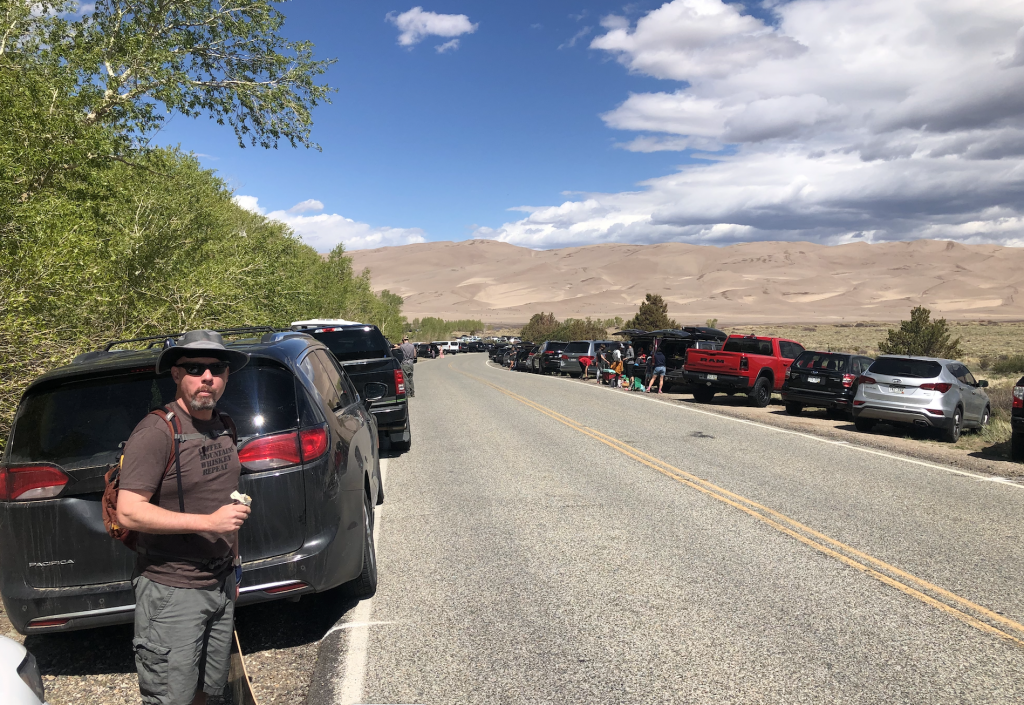
For the sledding part, we only carried our sleds and everything else went into our day packs.
When we switched out our sleds to our “lounge on the creek” gear at about 12:30pm, the park rangers were gone and we could move our vehicle right up front. We had a very short walk with our camp chairs, beach towels, and drink cooler. Perfect!
To Sled…or Not to Sled?
I say, “Give it a shot.” Sleds are available to rent at outlets throughout the area*, but the most popular place is probably the Great Sand Dunes Oasis, which is a restaurant/gift shop/lodge/campground just outside the park’s main gate. This is where Dave and I got our sleds. We arrived at about 10am, and it was a 20-30 minute wait to rent our sleds. Be sure to program this time into your visit.
*I heard a rumor that there are places in Denver and Colorado Springs to rent the sand boards for the weekend, so as not to have to delay your day at the park, but I haven’t thoroughly researched that.
The store and restaurant were operating under COVID-related rules, so we couldn’t see much at all. There were porta-potties outside for the long line of people waiting to rent sleds.
Sled rentals were $20/day, and users could choose a stand-up sled (like a snowboard) or a sit-down sled (like a child’s snow sled). You receive a block of wax with which you are supposed to wax the bottom of the sled before each run.
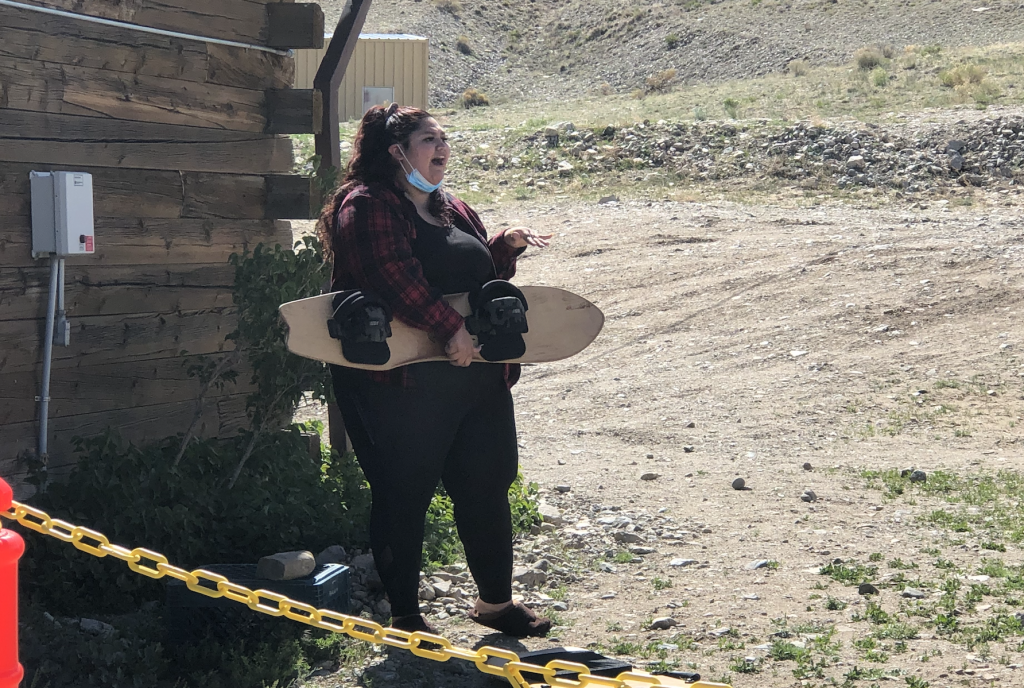
We saw many people attempting to use their personal skis and snowboards on the dunes. This is NOT a good idea. Not only does the sand scour away the bottom surfaces but there are random large rocks under the sand that could make even more of a mess of your expensive equipment.
We also saw folks using inexpensive plastic sleds, like the ones you get at Walmart. Those will work well if you have some wax to apply to the underside. Dave and I gave one of our blocks of wax — that was given to us with our sled rentals — to a family with a plastic sled and they told us it made a huge difference.
Dave and I made a number of runs with our sleds. It forces you to wander the dunes quite a bit, in search of the perfect run. But remember, to make a run down a dune, you have to climb up it first. This isn’t easy.

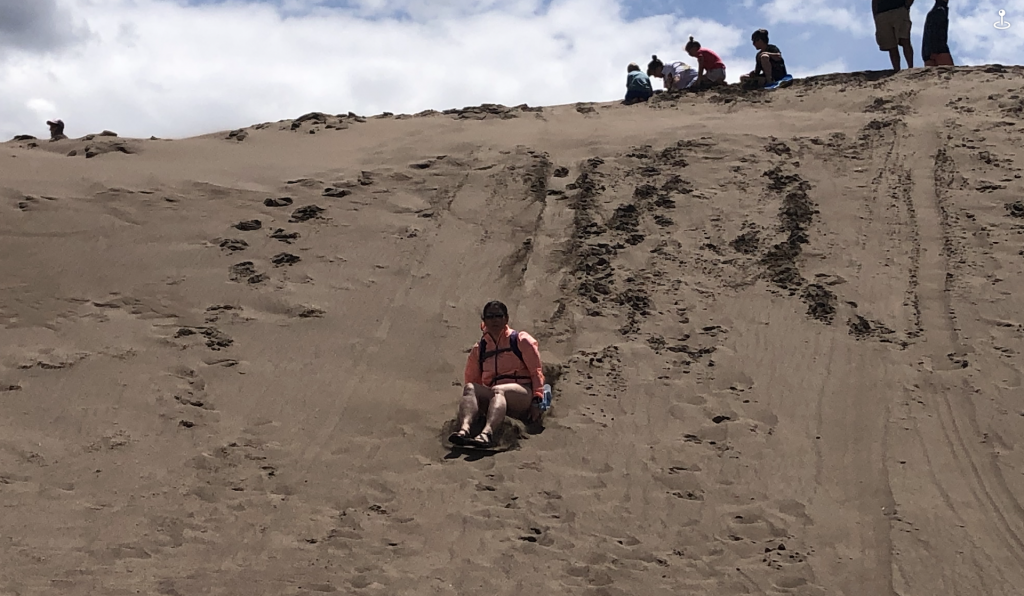
Enjoy this video of the longest run Dave and I made:
We didn’t do more than 4-5 runs each. It was exhausting to climb up the dunes, and the wind was whipping sand everywhere. I would recommend swimming or ski goggles for younger folks, to keep the sand out of their eyes. But you don’t want anything too fancy, because that sand could scratch the lenses.
Patricia’s Advice? At least try it once.
Hanging at Medano Creek
After about 90 minutes of sledding, Dave and I went back to the car to switch out our gear, from “sledding” mode to “lounging on the beach” mode.
We were able to set up on the east side of the creek under some trees that provided shade at first, but then as the sun worked its way across the sky, it got sunnier.

Dave and I enjoyed lunch, some beverages, and plenty of people watching. We loved seeing the kids playing with their inner tubes, dogs running around in the water (dogs are allowed!), and the creek water flowing in many different directions, undulating as the sand terrain changed underneath it.
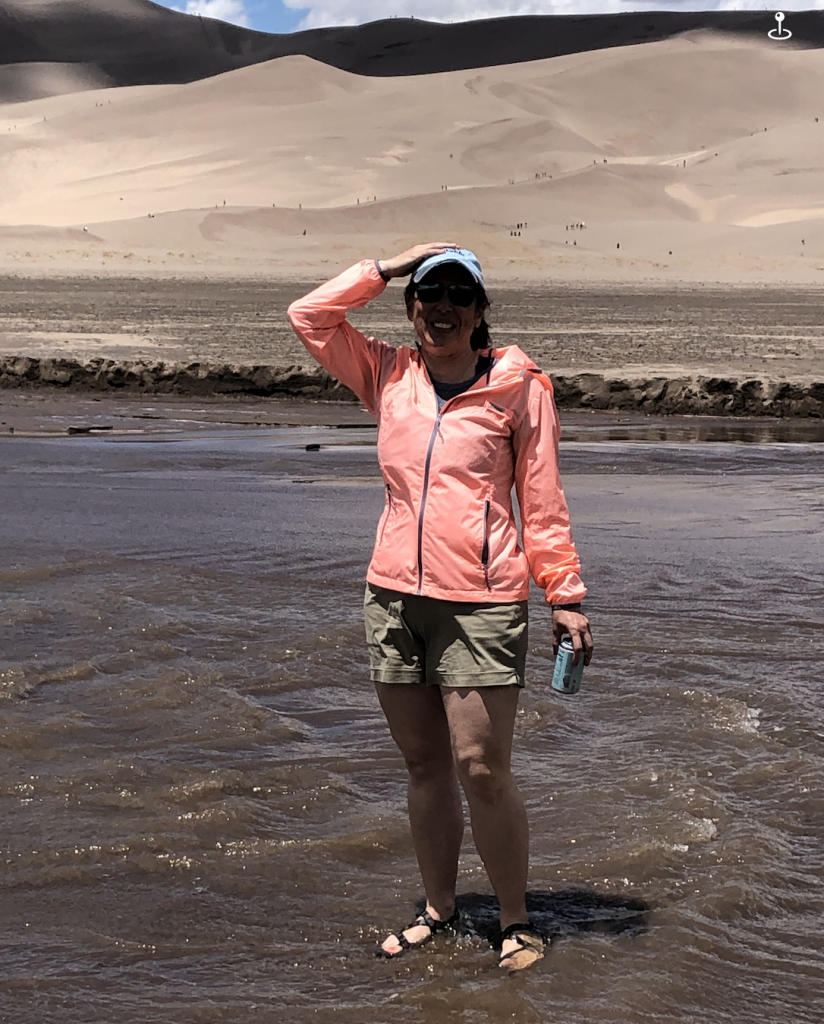
We simply sat and enjoyed the view for another 2 hours or so, before the wind started to pick up even more, and the clouds came in. This made things downright chilly, and we decided it was time to go.
Visitor Center
After hanging out at the creek, we drove around the rest of the paved part of the park, including the campground, and we noticed some trailheads. We ended up not taking any of the trails in the park, although the Mosca Trail looked appealing to me.
We stopped at the Visitor Center to pick up a sticker for Bojack (we have a sticker board mounted inside). This was a strange experience. Even though most of the government had opened back up from most COVID-related restrictions, including relaxing capacity limits and mask mandates for vaccinated people.
But this Visitor Center was still limiting entry to 10 guests at a time, and masks were still required, even for those of us vaccinated.
Dave and I waited over 1/2 hour outside to get into the Visitor Center/gift shop. Most of the Visitor Center was closed, and I felt very rushed in the gift shop. We got our sticker — as well as a pretty Christmas ornament — and quickly left.
Food
Unlike the bigger national parks we’ve been to over the years, this park does not have any restaurants on site. There are convenience-store-like options at the Visitor Center and at the General Store in the Pinyon Flats campground. That’s it.
You can get snacks at the Oasis general store, also.
As I mentioned above in the “packing” section, I highly recommend bringing picnic-style foods into the park and just enjoying it on the creek or on the dunes themselves. Dave and I did that and it was wonderful.
Camping
While Dave and I stayed with Bojack at the Base Camp Family Campground near the Highway 160 turnoff into the park, there is a campground in the park itself, and my neighbors can attest to how nice it is.
The Pinyon Flats Campground has 88 sites, many of which able to accommodate RVs up to 25′, but with no hookups. There are water spigots and toilets/dishwashing sinks nearby. No showers.
That being said, there are plenty of shade trees and the views of the dunes from many of the sites are magnificent.
If you’re interested in camping in the park itself, you need to plan well in advance. Use Reservation.gov to reserve up to 365 days in advance: the month of May — especially the weekends — will get swiped up pretty quickly!
Conclusions
It was Dave’s and my first visit to GSDNP. It was absolutely beautiful and I highly recommend at least one full day there! We saw quite a bit in a day, but there were things we didn’t get to do in that one day — mainly the hiking. Also, the restrictions on the Visitor Center made for an unpleasant experience there….so maybe things will be back to normal by the time we visit again.
